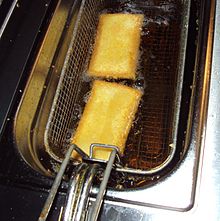Deep frying
Deep frying is a cooking method in which food is submerged in hot fat e.g. oil. This is normally performed with a deep fryer or chip pan; industrially, a pressure fryer or vacuum fryer may be used. Deep frying is classified as a dry cooking method because no water is used. Due to the high temperature involved and the high heat conduction of oil, it cooks food extremely quickly.

If performed properly, deep-frying does not make food excessively greasy, because the moisture in the food repels the oil. The hot oil heats the water within the food, steaming it; oil cannot go against the direction of this powerful flow because (due to its high temperature) the water vapor pushes the bubbles toward the surface.[1] As long as the oil is hot enough and the food is not immersed in the oil for too long, oil penetration will be confined to the outer surface. However, if the food is cooked in the oil for too long, much of the water will be lost and the oil will begin to penetrate the food. The correct frying temperature depends on the thickness and type of food, but in most cases it lies between 175 and 190 °C (345–375 °F). [edit]Oil deterioration Overheating or over-using the frying oil leads to formation of rancid-tasting products of oxidation, polymerization, and other deleterious, unintended or even toxic compounds [2] such as acrylamide (from starchy foods). Deep-frying under vacuum helps to significantly reduce acrylamide formation,[3] but this process is not widely used in the food industry due to the high investment cost involved. Some useful tests and indicators of excessive oil deterioration are the following: Sensory: Darkening, smoke, foaming, thickening, rancid taste and unpleasant smell when heating. Laboratory: Acidity, anisidine value, viscosity, total polar compounds, polymeric triglycerides. Instruments that indicate total polar compounds, currently the best single gauge of how deep-fried an object is, are available with sufficient accuracy for restaurant and industry use. Deep frying produces large amounts of waste oil, which must be properly disposed. Waste oil is increasingly being recycled into biodiesel. Fires when deep frying can be very severe, and chip pan fires are the leading cause of house fires in the United Kingdom Cooking oil is flammable, and fires may be caused by it igniting at too high a temperature. Further, attempts to extinguish an oil fire with water cause an extremely dangerous condition, a boilover, as it causes the water to flash into steam due to the high heat of the oil, in turn sending the burning oil in all directions and thus aggravating the fire. This is the leading cause of house fires in the United Kingdom. Instead, oil fires must be extinguished via fire extinguisher or by smothering. Other means of extinguishing an oil fire include application of dry powder (e.g., baking soda, salt) or fire fighting foam. Most commercial deep fryers are equipped with automatic fire suppression systems using foam. Spilled hot cooking oil can also cause severe, even fatal, burns. The higher temperatures and tendency of oil to stick to the skin make spilled hot cooking oil far more dangerous than spilled hot water. Children are particularly at risk, as they can accidentally pull a pot off the stove onto themselves. Cooking with oil also tends to make a mess, with oil splatters on all adjacent surfaces, and oil vapors condensing on more distant surfaces. More detergent is also needed to clean cooking pots and utensils coated in oil.